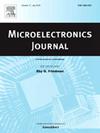An analytical I-V model of SiC double-gate junctionless MOSFETs
IF 1.9
3区 工程技术
Q3 ENGINEERING, ELECTRICAL & ELECTRONIC
引用次数: 0
Abstract
Silicon carbide(SiC) double gate junctionless metal oxide semiconductor field-effect transistors(DG JL MOSFETs) have attracted significant attention due to their ideal high temperature characteristics and radiation resistance. Therefore, it is meaningful to exploit an I-V model for SiC DG JL MOSFETs. In this article, we make a linear approximation to describe the relationship between the surface mobile charge density and the surface electron concentration of the device. Based on this approximation and using the one-dimensional Poisson’s equation, we solve for the potential distribution of a SiC DG JL MOSFET in the subthreshold region. From this solution, we derived a functional relationship between the surface mobile charge density in the channel and the channel quasi-Fermi potential. Then we successfully developed a unified I-V model for the SiC DG JL MOSFETs. Based on the drain to source current calculation formula, the calculation expressions for the device’s transconductance and output conductance are derived. By comparing our model with the results from the two-dimensional numerical simulation software Silvaco Atlas, our model’s calculations closely match the two-dimensional numerical simulation results from the subthreshold region to the accumulation region. This model has reference significance for SiC DG JL MOSFETs in the high temperature electronic circuit application field.
碳化硅双栅极无结 MOSFET 的 I-V 分析模型
碳化硅(SiC)双栅无结金属氧化物半导体场效应晶体管(DG JL MOSFET)因其理想的高温特性和抗辐射能力而备受关注。因此,利用 SiC DG JL MOSFET 的 I-V 模型是非常有意义的。在本文中,我们采用线性近似来描述器件表面移动电荷密度和表面电子浓度之间的关系。根据这一近似值并利用一维泊松方程,我们求解了阈下区 SiC DG JL MOSFET 的电势分布。根据这一解法,我们得出了沟道中表面移动电荷密度与沟道准费米电势之间的函数关系。然后,我们成功建立了 SiC DG JL MOSFET 的统一 I-V 模型。根据漏极至源极电流计算公式,得出了器件的跨导和输出电导的计算表达式。通过将我们的模型与二维数值模拟软件 Silvaco Atlas 的结果进行比较,我们模型的计算结果与从亚阈值区到累积区的二维数值模拟结果非常吻合。该模型对于高温电子电路应用领域的 SiC DG JL MOSFET 具有参考意义。
本文章由计算机程序翻译,如有差异,请以英文原文为准。
求助全文
约1分钟内获得全文
求助全文
来源期刊

Microelectronics Journal
工程技术-工程:电子与电气
CiteScore
4.00
自引率
27.30%
发文量
222
审稿时长
43 days
期刊介绍:
Published since 1969, the Microelectronics Journal is an international forum for the dissemination of research and applications of microelectronic systems, circuits, and emerging technologies. Papers published in the Microelectronics Journal have undergone peer review to ensure originality, relevance, and timeliness. The journal thus provides a worldwide, regular, and comprehensive update on microelectronic circuits and systems.
The Microelectronics Journal invites papers describing significant research and applications in all of the areas listed below. Comprehensive review/survey papers covering recent developments will also be considered. The Microelectronics Journal covers circuits and systems. This topic includes but is not limited to: Analog, digital, mixed, and RF circuits and related design methodologies; Logic, architectural, and system level synthesis; Testing, design for testability, built-in self-test; Area, power, and thermal analysis and design; Mixed-domain simulation and design; Embedded systems; Non-von Neumann computing and related technologies and circuits; Design and test of high complexity systems integration; SoC, NoC, SIP, and NIP design and test; 3-D integration design and analysis; Emerging device technologies and circuits, such as FinFETs, SETs, spintronics, SFQ, MTJ, etc.
Application aspects such as signal and image processing including circuits for cryptography, sensors, and actuators including sensor networks, reliability and quality issues, and economic models are also welcome.
 求助内容:
求助内容: 应助结果提醒方式:
应助结果提醒方式:


